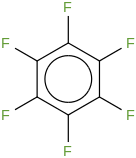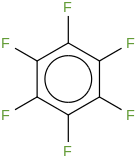Selected ATcT [1, 2] enthalpy of formation based on version 1.172 of the Thermochemical Network [3]
This version of ATcT results[3] was generated by additional expansion of version 1.156 to include species relevant to a study of photodissociation of formamide[4].Fluorobenzene
2D Image:

| ΔfH°(0 K) | ΔfH°(298.15 K) | Uncertainty | Units |
|---|---|---|---|
| -148.77 | -146.36 | ± 0.39 | kJ/mol |
Top contributors to the provenance of ΔfH° of C6H5F (cr,l)
The 20 contributors listed below account only for 87.4% of the provenance of ΔfH° of C6H5F (cr,l).A total of 29 contributors would be needed to account for 90% of the provenance.
Please note: The list is limited to 20 most important contributors or, if less, a number sufficient to account for 90% of the provenance. The Reference acts as a further link to the relevant references and notes for the measurement. The Measured Quantity is normaly given in the original units; in cases where we have reinterpreted the original measurement, the listed value may differ from that given by the authors. The quoted uncertainty is the a priori uncertainty used as input when constructing the initial Thermochemical Network, and corresponds either to the value proposed by the original authors or to our estimate; if an additional multiplier is given in parentheses immediately after the prior uncertainty, it corresponds to the factor by which the prior uncertainty needed to be multiplied during the ATcT analysis in order to make that particular measurement consistent with the prevailing knowledge contained in the Thermochemical Network.
| Contribution (%) | TN ID | Reaction | Measured Quantity | Reference |
|---|---|---|---|---|
| 15.7 | 7255.1 | C6F6 (g) + 5 C6H6 (g) → 6 C6H5F (g) | ΔrH°(0 K) = -32.57 ± 0.90 kcal/mol | Ruscic G3X |
| 15.7 | 7255.2 | C6F6 (g) + 5 C6H6 (g) → 6 C6H5F (g) | ΔrH°(0 K) = -32.98 ± 0.90 kcal/mol | Ruscic G4 |
| 15.7 | 7255.4 | C6F6 (g) + 5 C6H6 (g) → 6 C6H5F (g) | ΔrH°(0 K) = -32.05 ± 0.90 kcal/mol | Ruscic CBS-n |
| 12.7 | 7255.3 | C6F6 (g) + 5 C6H6 (g) → 6 C6H5F (g) | ΔrH°(0 K) = -32.44 ± 1.0 kcal/mol | Ruscic CBS-n |
| 10.9 | 7259.1 | 999 C6F6 (cr,l) + 999 O2 (g) → 999 CO2 (g) + 999 CF4 (g) + 834 F2 (g) | ΔrH°(298.15 K) = -469109 ± 200 kcal/mol | Krech 1972 |
| 3.1 | 6837.3 | C6H6 (cr,l) + 15/2 O2 (g) → 6 CO2 (g) + 3 H2O (cr,l) | ΔrH°(298.15 K) = -780.97 ± 0.09 kcal/mol | Coops 1947, Coops 1946 |
| 2.5 | 6837.4 | C6H6 (cr,l) + 15/2 O2 (g) → 6 CO2 (g) + 3 H2O (cr,l) | ΔrH°(298.15 K) = -780.92 ± 0.10 kcal/mol | Good 1969 |
| 2.5 | 6837.1 | C6H6 (cr,l) + 15/2 O2 (g) → 6 CO2 (g) + 3 H2O (cr,l) | ΔrH°(298.15 K) = -780.98 ± 0.10 kcal/mol | Prosen 1945a, as quoted by Cox 1970 |
| 1.7 | 6837.2 | C6H6 (cr,l) + 15/2 O2 (g) → 6 CO2 (g) + 3 H2O (cr,l) | ΔrH°(298.15 K) = -780.96 ± 0.12 kcal/mol | Cox 1970 |
| 1.4 | 2228.7 | C (graphite) + O2 (g) → CO2 (g) | ΔrH°(298.15 K) = -393.464 ± 0.024 kJ/mol | Hawtin 1966, note CO2e |
| 0.7 | 7245.1 | C6H5F (cr,l) + 7 O2 (g) → 6 CO2 (g) + HF (aq, 60 H2O) + 2 H2O (cr,l) | ΔrH°(298.15 K) = -741.88 ± 0.29 (×3.364) kcal/mol | Good 1956 |
| 0.6 | 2375.1 | 2 H2 (g) + C (graphite) → CH4 (g) | ΔrG°(1165 K) = 37.521 ± 0.068 kJ/mol | Smith 1946, note COf, 3rd Law |
| 0.5 | 125.2 | 1/2 O2 (g) + H2 (g) → H2O (cr,l) | ΔrH°(298.15 K) = -285.8261 ± 0.040 kJ/mol | Rossini 1939, Rossini 1931, Rossini 1931b, note H2Oa, Rossini 1930 |
| 0.5 | 2228.5 | C (graphite) + O2 (g) → CO2 (g) | ΔrH°(298.15 K) = -393.468 ± 0.038 kJ/mol | Fraser 1952, note CO2f |
| 0.5 | 2228.4 | C (graphite) + O2 (g) → CO2 (g) | ΔrH°(298.15 K) = -393.462 ± 0.038 kJ/mol | Lewis 1965, note CO2d |
| 0.5 | 7246.8 | C6H5F (g) + CH4 (g) → C6H6 (g) + CH3F (g) | ΔrH°(0 K) = 8.71 ± 0.9 kcal/mol | Ruscic W1RO |
| 0.4 | 7246.7 | C6H5F (g) + CH4 (g) → C6H6 (g) + CH3F (g) | ΔrH°(0 K) = 9.08 ± 1.0 kcal/mol | Ruscic CBS-n |
| 0.4 | 7246.4 | C6H5F (g) + CH4 (g) → C6H6 (g) + CH3F (g) | ΔrH°(0 K) = 8.76 ± 1.0 kcal/mol | Ruscic G4 |
| 0.3 | 2228.11 | C (graphite) + O2 (g) → CO2 (g) | ΔrH°(298.15 K) = -94.051 ± 0.011 kcal/mol | Prosen 1944a, Cox 1970, NBS TN270, NBS Tables 1989 |
| 0.3 | 4036.1 | C6H6 (g) + 3 H2 (g) → CH2(CH2CH2CH2CH2CH2) (g) | ΔrH°(355. K) = -49.84 ± 0.15 (×1.384) kcal/mol | Kistiakowsky 1936 |
Top 10 species with enthalpies of formation correlated to the ΔfH° of C6H5F (cr,l)
The correlation coefficient is a number from -1 to 1, with 1 representing perfectly correlated species, -1 representing perfectly anti-correlated species, and 0 representing perfectly uncorrelated species.
| Correlation Coefficent (%) | Species Name | Formula | Image | ΔfH°(0 K) | ΔfH°(298.15 K) | Uncertainty | Units | Relative Molecular Mass | ATcT ID |
|---|---|---|---|---|---|---|---|---|---|
| 99.5 | Fluorobenzene | C6H5F (g) |  | -96.05 | -111.73 | ± 0.39 | kJ/mol | 96.1023 ± 0.0048 | 462-06-6*0 |
| 99.2 | Fluorobenzene cation | [C6H5F]+ (g) | ![c1ccc(cc1)[F+]](../images/694.png) | 791.92 | 776.90 | ± 0.39 | kJ/mol | 96.1018 ± 0.0048 | 34468-25-2*0 |
| 45.7 | Benzene | C6H6 (g) |  | 100.68 | 83.17 | ± 0.21 | kJ/mol | 78.1118 ± 0.0048 | 71-43-2*0 |
| 45.7 | Benzene cation | [C6H6]+ (g) | ![c1ccc(cc1)[H+]](../images/1104.png) | 992.57 | 976.11 | ± 0.21 | kJ/mol | 78.1113 ± 0.0048 | 34504-50-2*0 |
| 45.7 | Benzene | C6H6 (cr,l) |  | 50.77 | 49.23 | ± 0.21 | kJ/mol | 78.1118 ± 0.0048 | 71-43-2*500 |
| 37.2 | Hexafluorobenzene | C6F6 (g) |  | -942.56 | -947.56 | ± 0.87 | kJ/mol | 186.0546 ± 0.0048 | 392-56-3*0 |
| 37.1 | Hexafluorobenzene cation | [C6F6]+ (g) | ![Fc1c(F)c(F)c(F)c(F)c1[F+]](../images/2376.png) | 13.68 | 9.89 | ± 0.87 | kJ/mol | 186.0541 ± 0.0048 | 34528-23-9*0 |
| 37.0 | Hexafluorobenzene | C6F6 (cr,l) |  | -997.17 | -983.38 | ± 0.87 | kJ/mol | 186.0546 ± 0.0048 | 392-56-3*500 |
| 24.0 | Phenide | [C6H5]- (g) | ![c1cccc[c-]1](../images/166.png) | 244.25 | 230.83 | ± 0.38 | kJ/mol | 77.1044 ± 0.0048 | 30922-78-2*0 |
| 23.8 | Fluorobenzene anion | [C6H5F]- (g) | ![c1ccc(cc1)[F-]](../images/1808.png) | -15.3 | -27.1 | ± 1.6 | kJ/mol | 96.1029 ± 0.0048 | 34561-55-2*0 |
Most Influential reactions involving C6H5F (cr,l)
Please note: The list, which is based on a hat (projection) matrix analysis, is limited to no more than 20 largest influences.| 1 |
B. Ruscic, R. E. Pinzon, M. L. Morton, G. von Laszewski, S. Bittner, S. G. Nijsure, K. A. Amin, M. Minkoff, and A. F. Wagner, Introduction to Active Thermochemical Tables: Several "Key" Enthalpies of Formation Revisited. J. Phys. Chem. A 108, 9979-9997 (2004) [DOI: 10.1021/jp047912y] |
|
| 2 |
B. Ruscic, R. E. Pinzon, G. von Laszewski, D. Kodeboyina, A. Burcat, D. Leahy, D. Montoya, and A. F. Wagner, Active Thermochemical Tables: Thermochemistry for the 21st Century. J. Phys. Conf. Ser. 16, 561-570 (2005) [DOI: 10.1088/1742-6596/16/1/078] |
|
| 3 |
B. Ruscic and D. H. Bross, Active Thermochemical Tables (ATcT) values based on ver. 1.172 of the Thermochemical Network (2024); available at ATcT.anl.gov |
|
| 4 |
K. L. Caster, N. A. Seifert, B. Ruscic, A. W. Jasper, and K. Prozument, Dynamics of HCN, NHC, and HNCO Formation in the 193 nm Photodissociation of Formamide J. Phys. Chem. A (in press) (2024) [DOI: 10.1021/acs.jpca.4c02232] |
|
| 5 |
B. Ruscic, Uncertainty Quantification in Thermochemistry, Benchmarking Electronic Structure Computations, and Active Thermochemical Tables. Int. J. Quantum Chem. 114, 1097-1101 (2014) [DOI: 10.1002/qua.24605] |
|
| 6 |
B. Ruscic and D. H. Bross, Thermochemistry Computer Aided Chem. Eng. 45, 3-114 (2019) [DOI: 10.1016/B978-0-444-64087-1.00001-2] |
Note that an uncertainty of ± 0.000 kJ/mol indicates that the estimated uncertainty is < ± 0.0005 kJ/mol.
The find function is based on the complete Species Dictionary entries for the appropriate version of the ATcT TN.
The molecule images are rendered by Indigo-depict.
The XYZ renderings are based on Jmol: an open-source Java viewer for chemical structures in 3D. http://www.jmol.org/.